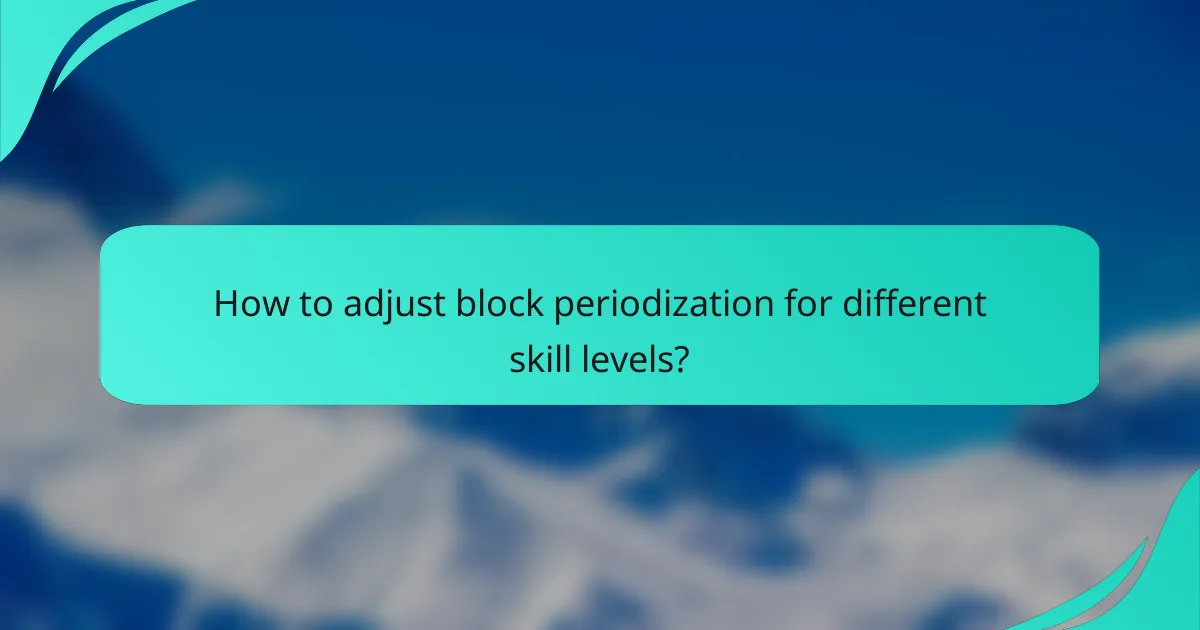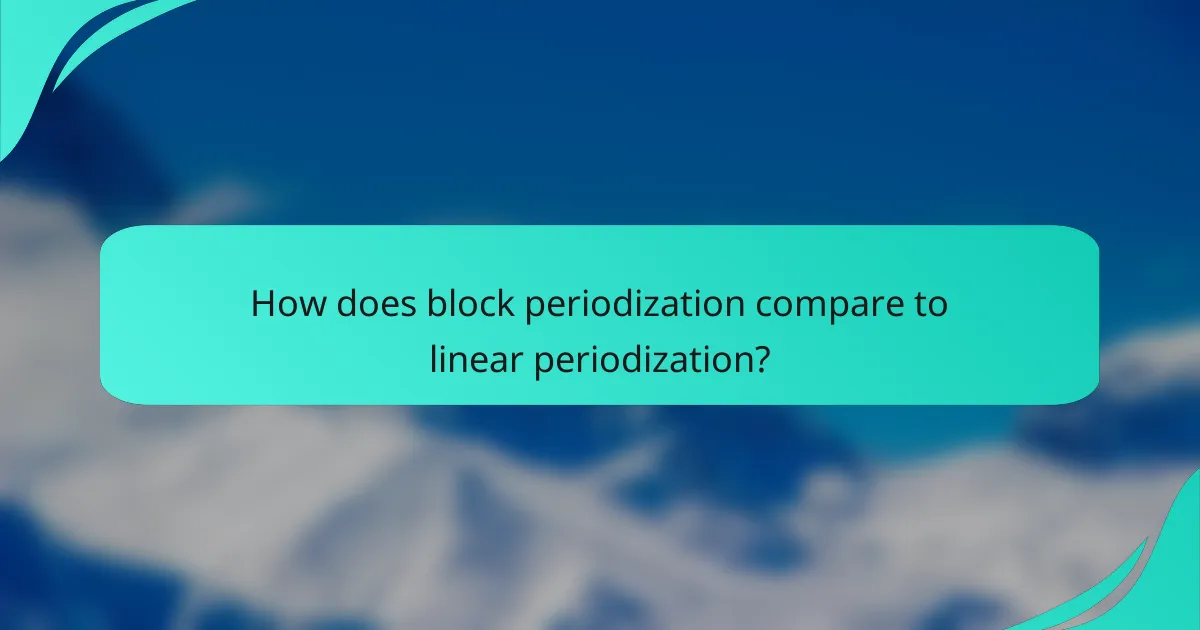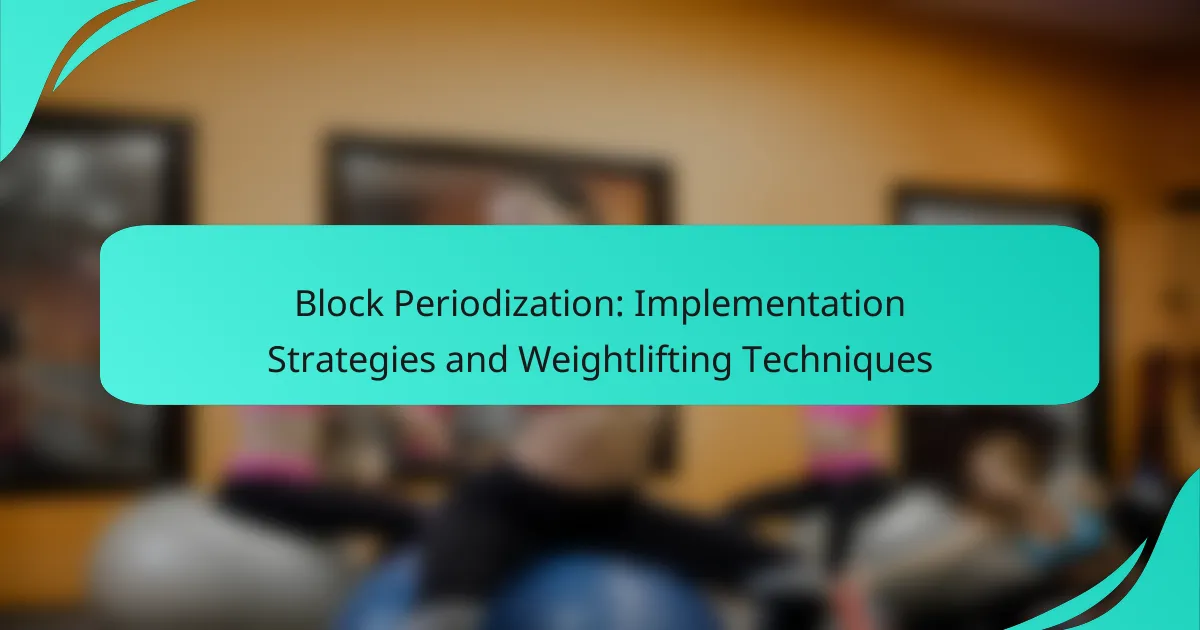Block periodization is a strategic approach to weightlifting that organizes training into distinct phases, each aimed at specific goals such as strength, hypertrophy, or power. This method enhances performance by allowing athletes to focus intensively on one aspect at a time, leading to optimized strength development and improved recovery. Complementing this approach with targeted weightlifting techniques, such as Olympic lifting and powerlifting strategies, further enhances the effectiveness of the training program.

How to implement block periodization in weightlifting?
Implementing block periodization in weightlifting involves structuring training into distinct phases, each focusing on specific goals such as strength, hypertrophy, or power. This method allows athletes to maximize performance by concentrating on one aspect of training at a time, leading to improved results over time.
Step-by-step implementation guide
Begin by assessing the athlete’s current level, goals, and competition schedule. Divide the training year into blocks, typically lasting 3-6 weeks each, focusing on different training modalities. For example, the first block may emphasize hypertrophy, followed by a strength block, and concluding with a power block.
During each block, design workouts that progressively overload the athlete while incorporating adequate recovery. Ensure that the intensity and volume are adjusted according to the block’s focus, with lower volume and higher intensity for power training, and higher volume for hypertrophy.
Key considerations for athletes
Individualization is crucial; each athlete may respond differently to block periodization based on their experience, recovery ability, and specific goals. Monitor progress closely and be prepared to adjust the training plan based on performance metrics and feedback.
Recovery strategies should be integrated throughout the training blocks. This includes proper nutrition, sleep, and active recovery techniques to ensure athletes can handle the increased demands of each phase.
Common mistakes to avoid
Avoid the pitfall of insufficient recovery between blocks, as this can lead to burnout or injury. Ensure that athletes have adequate rest periods before transitioning to a new block to allow for full adaptation.
Another common mistake is neglecting to track progress. Regularly assess performance metrics, such as lifts and endurance, to determine the effectiveness of each block and make necessary adjustments.
Lastly, do not rush through the blocks. Each phase should be completed fully before moving on to the next to maximize the benefits of block periodization.

What are the benefits of block periodization?
Block periodization offers several advantages, including optimized strength development, improved recovery, and enhanced focus during training sessions. By structuring training into distinct blocks, athletes can target specific goals more effectively and manage fatigue better.
Improved strength gains
One of the primary benefits of block periodization is the potential for improved strength gains. By concentrating on specific training modalities within each block, athletes can maximize their performance in strength-focused phases, often leading to greater overall increases in muscle power and size.
For example, a typical block might focus solely on hypertrophy for several weeks, followed by a block dedicated to maximal strength. This targeted approach allows for more effective adaptations compared to traditional linear models.
Enhanced recovery periods
Block periodization facilitates enhanced recovery periods, which are essential for long-term performance. By alternating between high-intensity and lower-intensity blocks, athletes can allow their bodies to recover adequately while still making progress.
In practice, this means incorporating deload weeks or lighter training phases after intense blocks, helping to prevent overtraining and reduce the risk of injury. Athletes should aim for recovery blocks that last at least one week to ensure proper adaptation.
Increased training focus
With block periodization, athletes can increase their training focus by dedicating specific timeframes to particular goals. This structured approach helps eliminate distractions and allows for concentrated effort on skill development or strength enhancement.
For instance, during a block focused on Olympic weightlifting techniques, athletes can prioritize form and technique without the interference of other training modalities. This focused training can lead to significant improvements in performance metrics over time.

Which weightlifting techniques complement block periodization?
Block periodization can be effectively complemented by specific weightlifting techniques that enhance strength and power development. Key techniques include Olympic lifting, powerlifting strategies, and accessory exercises, each serving distinct purposes in a structured training program.
Olympic lifting techniques
Olympic lifting techniques, such as the clean and jerk and the snatch, are essential for developing explosive strength and power. These lifts require coordination, speed, and technique, making them ideal for athletes seeking to improve their overall athletic performance.
When incorporating Olympic lifts into a block periodization program, focus on mastering the technique during the initial phases before increasing intensity. Aim for 2-4 sets of 2-5 repetitions at 70-90% of your one-rep max, depending on the training block.
Powerlifting strategies
Powerlifting strategies center around the squat, bench press, and deadlift, which are crucial for building maximal strength. These lifts can be integrated into block periodization by focusing on different aspects, such as hypertrophy, strength, and peaking phases.
During hypertrophy blocks, perform 3-5 sets of 6-10 repetitions at 60-75% of your one-rep max. In strength blocks, shift to 3-5 sets of 3-5 repetitions at 80-90%. Ensure adequate recovery between sets to maintain performance quality.
Accessory exercises
Accessory exercises support the main lifts by targeting specific muscle groups and improving weaknesses. These can include movements like lunges, rows, and tricep extensions, which enhance overall strength and stability.
Incorporate accessory exercises into your training routine with 2-4 sets of 8-12 repetitions at moderate loads. Focus on exercises that complement your primary lifts and address any imbalances, ensuring a well-rounded strength development approach.

What are the prerequisites for block periodization?
Block periodization requires a solid foundation in strength training and an understanding of how to structure training phases effectively. Key prerequisites include a baseline strength assessment and a clear grasp of the different training phases involved in this method.
Baseline strength assessment
To implement block periodization successfully, begin with a baseline strength assessment. This involves evaluating your current strength levels across major lifts, such as the squat, deadlift, and bench press. Knowing your starting point helps in setting realistic goals and tracking progress.
Consider using standardized tests, such as one-rep max (1RM) evaluations, to determine your strength levels. This data will inform your training loads and help in adjusting your program as you progress. Regular assessments every few months can help gauge improvements and adapt your training accordingly.
Understanding training phases
Block periodization is divided into distinct training phases, each focusing on specific adaptations. Typically, these phases include accumulation, intensification, and realization. Understanding these phases is crucial for optimizing performance and recovery.
The accumulation phase emphasizes volume and technique, while the intensification phase shifts focus to higher intensity with lower volume. Finally, the realization phase is where athletes peak for competition or testing. Familiarizing yourself with the duration and goals of each phase can enhance your training effectiveness.

How to adjust block periodization for different skill levels?
Adjusting block periodization for varying skill levels involves tailoring training volume, intensity, and recovery strategies to match the athlete’s experience. Beginners require more foundational work, while advanced athletes can handle greater complexity and intensity.
Beginner adaptations
For beginners, block periodization should focus on developing fundamental movement patterns and building a solid strength base. Training cycles can include longer blocks of hypertrophy to increase muscle mass, followed by strength blocks that emphasize proper lifting techniques.
Consider starting with a three-phase cycle: a hypertrophy phase lasting 4-6 weeks, followed by a strength phase of 3-4 weeks, and a deload phase of 1 week. This structure allows for gradual progression while minimizing the risk of injury.
Advanced athlete modifications
Advanced athletes can benefit from more complex block periodization strategies that incorporate varied intensities and specific goals. These athletes may utilize shorter, more intense blocks, such as 2-3 weeks of peaking for competition, followed by a recovery phase.
Incorporating techniques such as wave loading or undulating periodization can enhance performance. For instance, an advanced lifter might alternate between heavy, moderate, and light days within a single week to optimize strength gains while allowing for recovery.

What tools can assist in block periodization?
Several tools can enhance the effectiveness of block periodization, including training apps and weightlifting journals. These resources help track progress, manage workloads, and optimize training cycles for better performance outcomes.
Training apps like TrainHeroic
Training apps such as TrainHeroic provide structured programs tailored for block periodization. They allow athletes to customize their training plans, log workouts, and monitor progress over time.
When using these apps, focus on features like exercise libraries, performance tracking, and analytics. This can help identify strengths and weaknesses, enabling adjustments to training loads and recovery periods.
Be cautious of over-reliance on technology; ensure that the app complements your training rather than dictates it. Regularly assess how well the app’s recommendations align with your personal goals and needs.
Weightlifting journals
Weightlifting journals are practical tools for recording workouts, tracking progress, and reflecting on training experiences. Keeping a detailed log helps identify patterns and make informed adjustments in your block periodization approach.
When maintaining a journal, note key details such as exercise types, sets, reps, and weights lifted. This information can be invaluable for analyzing performance trends and planning future cycles.
Avoid vague entries; be specific about your goals and feelings during each session. This clarity will enhance your understanding of what works best for you and improve your overall training effectiveness.

How does block periodization compare to linear periodization?
Block periodization focuses on training specific physical qualities in dedicated blocks, while linear periodization gradually increases intensity over time. This method allows for more targeted adaptations and can lead to improved performance in weightlifting.
Key differences in approach
Block periodization divides training into distinct phases, each emphasizing a particular aspect such as strength, hypertrophy, or power. In contrast, linear periodization typically progresses through a single focus over a longer timeframe, gradually increasing intensity and volume. This segmented approach in block periodization allows athletes to peak for specific competitions more effectively.
Another key difference is the flexibility of block periodization. Athletes can adjust their training blocks based on performance feedback, allowing for real-time modifications. Linear periodization, however, follows a more rigid structure, which may not accommodate individual progress as effectively.
Effectiveness for various goals
Block periodization is particularly effective for athletes aiming for peak performance in specific events, as it allows for concentrated training on particular skills. For example, a weightlifter may focus on strength in one block and then switch to power in the next, optimizing their performance for competitions. This method is well-suited for sports with defined seasons or major events.
On the other hand, linear periodization may be more beneficial for beginners or those looking to build a solid foundation in strength and conditioning. This gradual approach can help prevent injury and ensure a steady progression in fitness levels. Athletes should consider their specific goals and experience when choosing between these two periodization methods.
